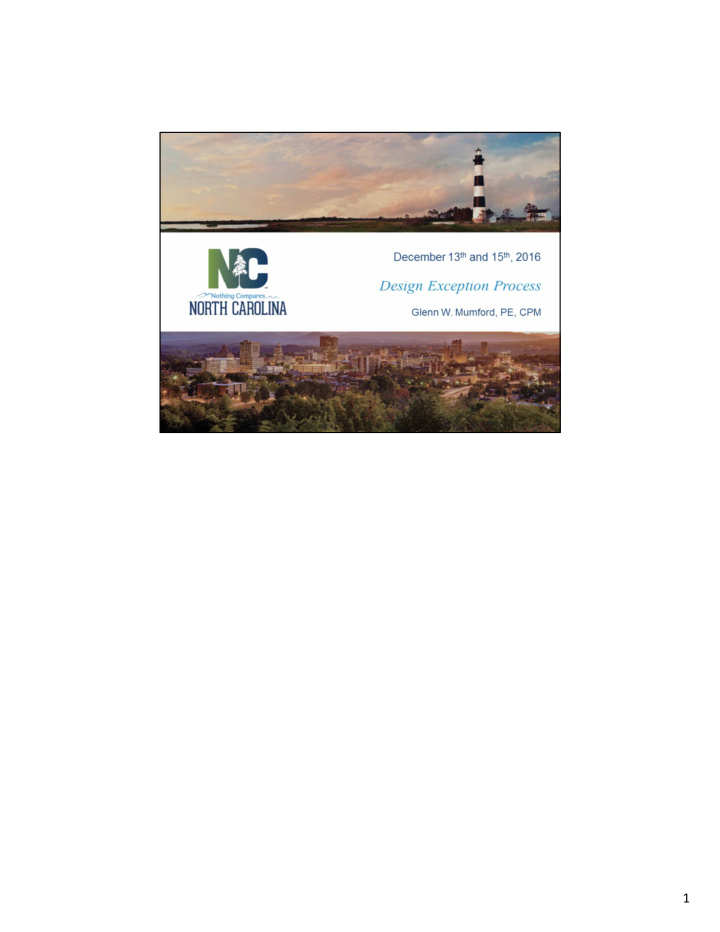



1
From the Design Exception Guidelines: 2
Bullet 1 : FHWA guidance says all NHS projects. NCDOT extends that to ALL STIP projects. Bullet 3 : Could be used for legal defense should legal actions arise. Shows that thought and judgement went into the decision. Bullet 4 : If the only exception is to facilitate a tie to existing, it does not have to be documented. The project has to end somewhere. 3
Comments on Specific Design Criteria: • Structural Capacity must be determined by the Structural Engineer not the Roadway Engineer. • Vertical SSD is usually determined mathematically using the formula in AASHTO. • Horizontal SSD is usually determined graphically. • Horizontal and Vertical Clearances over a roadway or railroad. (Some get this horizontal clearance confused with the horizontal offset on the bridge used to determine bridge width.) Transition: Changes for Design Exceptions: FHWA involvement – Oversight Agreement • Reduction in required elements. • 4
Design elements no longer requiring Design Exceptions include: Bridge Width • Vertical Alignment • Stopping Sight Distance for sag vertical curves • Horizontal Clearance • 5
Note that Design Speed plays into many of the other design criteria so this is not allowing a free for all. 6
This plays directly into the Design Speed discussion from the previous slide. 7
Next we will look at the two parts of the Design Exception documentation process. 8
Standard AASHTO Checklist: Three columns: Proposed design values AASHTO standard values Is an exception required? This example project required a design exception for Vertical Clearance. 9
Some key differences in SRT Guidelines that affect design criteria: • Uses current traffic instead of design year traffic for lane width and shoulder width • Allows for a reduction of 10 mph for horizontal curve radius • Allows for a reduction of 20 mph for vertical alignment K values and SSD • Bridge width is reduced Differences for Sub Regional Tier Checklist: • Additional Column for Sub Regional Tier Values • The “Exception Required” column must have two sets of responses Note the use of subscripts that correspond to notes under the “non- complying” design elements. 10
A column is added to show the AASHTO Standards for the new design speed that is requested. Like the Sub Regional Tier Checklist there will be two sets of YES/NO responses for each element. 11
Three Components of Design Exception Letter: Cover Letter Basic Project Information including : Elements Requiring Exception Traffic Classification Costs Basis for Exception Five Key Questions 12
Discuss the 5 Questions in More Depth 1) Accident History: A 3 year Accident History must be requested from Traffic Safety . 2) Future Upgrades: Not limited to TIP project improvements 3) Existing Roadway Outside Project: Immediately adjacent to the project. Sets context for the project in relation to the surrounding area. 4) Explanation of justification for exception: S ignificant extension to project limits (usually bridge projects), excessive impacts to natural resources, significant right of way costs, inconsistent with the surrounding area. 5) Mitigation: Could be as simple as evaluating the conditions once new facility is in operation. 13
Bullet 1: Keep in Project File Bullet 2: Things such as guardrail length of need reduction - document with note to file. Bullet 4: Description of justification for the exception needs to be documented in detail. 14
15
Recommend
More recommend